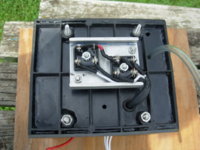Wow! Good progress there. My regulator barely gets warm and the rectifier is only ever warm to the touch. I see you have put the rectifier in a nice place for cooling too. When it is all up and running just touch the rectifier heat sink every so often when you stop the bike just to see how warm it is running.
Are you going to add a voltmeter to the bike? They are an excellent add-on and enable you in one quick glance to check the health of your charging system. They only cost a few dollars but boy are they reassuring when you glance down and see 14.1V or 14.2V.
Best of luck with the rest of the project.
Are you going to add a voltmeter to the bike? They are an excellent add-on and enable you in one quick glance to check the health of your charging system. They only cost a few dollars but boy are they reassuring when you glance down and see 14.1V or 14.2V.
Best of luck with the rest of the project.

